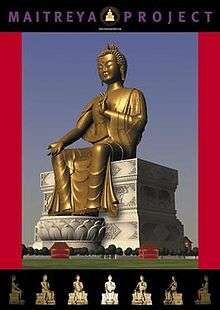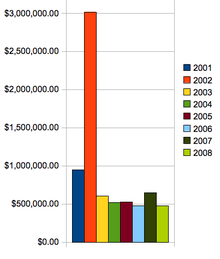Maitreya Project
The Maitreya Project is an international organisation, operating since 1990,[1] which intends to construct statues of Maitreya Buddha in India and perhaps elsewhere. Initial plans were for a 152-metre (500 ft) colossal statue, to be built in either Kushinagar or Bodhgaya. These plans have since changed, and the Maitreya Project now intends to construct relatively modest statues in both towns. The project was initiated by the Foundation for the Preservation of the Mahayana Tradition, an organisation within the Gelug school of Tibetan Buddhism.

Laying of the foundation stone in Kushinagar

On Friday 13 December 2013 the State Government of Uttar Pradesh handed over approximately 275 acres (111 ha) of land for the site of the Maitreya Project in Kushinagar. The land is immediately adjacent to the Parinirvana Temple denoting the place where Buddha Shakyamuni passed into Parinirvana, and the Rambhar Stupa which marks the holy site of Buddha’s cremation.
On that same day, the Chief Minister of Uttar Pradesh, Akhilesh Yadav, presided over a foundation stone laying ceremony on this land. Maitreya Project's Spiritual Director, Lama Zopa Rinpoche and the Board of Trustees of the Maitreya Project Trust attended as state guests.[2][3]
Finances

The Project reports for 1990–2008 outgoings of more than US$20 million and investment of more than US$11 million.[5]
Nita Ing has taken over responsibility for the funding of the statue in Bodhgaya.[6]
Criticism
There has been criticism in the press about some aspects of the Project,[7][8][10][11][12] including the compulsory acquisition, under "India's Land Acquisition Act", by the State Government[1] of 660 acres (2.7 km2) of private land, homes and small farms; which are intended to be leased to the Project, for construction of the statue and related infrastructure, including "landscaped park housing a cathedral, monastery, convent, guesthouse, library and food halls...".[13] Peter Kedge, former Director and CEO of the Maitreya Project has posted a number of replies to these criticisms.[1][14][15]
Following the 1,262nd day of "peaceful dharna", in August 2010, by the majority of local farmers against the compulsory acquisition of their farms, the Cabinet Secretary of Uttar Pradesh announced a reconsideration of support for the Project.[16]
References
- Kedge, Peter (November 2007). "Maitreya Project Update, November 2007". Maitreya Project International website. Maitreya Project International I.O.M. Retrieved 21 November 2007.
- "Laying the Foundation Stone on Maitreya Project Land". FPMT. Archived from the original on 20 July 2014. Retrieved 29 December 2014.
- "Announcement Maitreya Project Kushinagar" (PDF). FPMT. Retrieved 29 December 2014.
- "Registry Search Feature". Registry of Charitable Trusts (RCT). Office of the Attorney General, State of California. Retrieved 22 June 2010.
- "summary" (PDF). Maitreya Project website. Maitreya Project International. Retrieved 24 January 2013.
- Kedge, Peter. "Letter from Mr Peter Kedge". Maitreya Project.
- Pepper, Daniel (10 September 2007). "Indian farmers oppose giant Buddha statue". The Christian Science Monitor. The First Church of Christ, Scientist.
- Qadir, Abdul (9 January 2003). "Heavy police deployment made for Kalchakra". The Times of India. Times Internet Limited. Retrieved 4 March 2008.
- Pepper, Daniel (20 September 2007). "Villagers fight plan for giant Buddha". The Washington Times. News World Communications, Inc. Retrieved 27 April 2008.
- Falcone, Jessica. "Bodhi Blues — A Year in India: Questioning The Maitreya Project: What would the Buddha do?". Wild River Review. Wild River Review. Archived from the original on 11 February 2008. Retrieved 4 March 2008.
- Falcone, Jessica. "Bodhi Blues — A Year in India: What would the Buddha Do? The Debate Continues..." Wild River Review. Wild River Review. Archived from the original on 9 February 2008. Retrieved 4 March 2008.
- "X80F_Maitreya revised.pdf" (PDF). Aros Architects website. Aros Architects. Retrieved 4 March 2008.
- Kedge, Peter. "Maitreya Project, Latest Update, September 2007". Maitreya Project International website: Maitreya Project Update. Maitreya Project International I.O.M. Retrieved 10 November 2007.
- Kedge, Peter (September 2009). "Maitreya Project Status & Fact Reference, September 2009". Maitreya Project International website. Maitreya Project International I.O.M. Retrieved 26 September 2009.
- Manjul, Tarannum (24 August 2010). "Farmers' protests may drive away Maitreya Buddha project to Bihar". The Indian Express. The Indian Express Limited. Retrieved 4 July 2012.
Academic Papers
Falcone, Jessica. 2011. “The Buddhist Lama and the Indian Farmer: Negotiating Modernity and Tradition in the Development Plans for Kushinagar, India.” In Inequality in a Globalizing World: Perspectives, Processes, and Experiences, edited by Sangeeta Parashar Nandikotkur and Yong Wang, 107-117. Dubuque, IA: Kendall-Hunt Publishing.
External links
| Wikimedia Commons has media related to Maitreya Project. |
- Maitreya Project website
- Videos posted on YouTube by Maitreya Project
- BBC Documentary
- Pepper, Daniel Giant Buddha's tough love will drive out poor The Scotsman, 9 September 2007 on The Buddhist Channel
- Aros Architects Kushingar Masterplan with location map and simulated aerial view
- Fearing unrest, UP govt scales down Maitreya Buddha project Indian Express, Thu 26 May 2011.